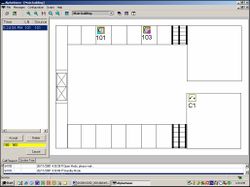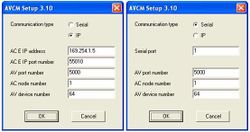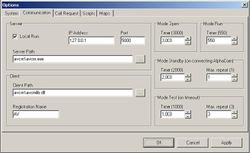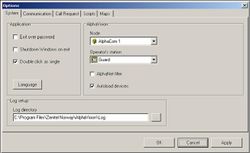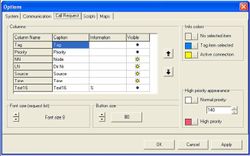AlphaVision
From Zenitel Wiki
AlphaVision is a PC based system management package for the AlphaCom exchange.
System Description
Configuration
AlphaVision can be used stand-alone as well as in a LAN-configuration. In stand-alone mode AlphaVision communicates directly with the AlphaCom exchange. In this mode it is possible to have multiple PC’s running AlphaVision, where each PC is connected to the exchange. Each PC is assigned a device number. The range of valid device numbers is between 1 and 64.
It is also possible to have only one PC connected to the exchange. All other PC’s running AlphaVision share the communications module which is running on the to the exchange connected PC. This is the LAN-configuration.
Features
The main purpose of AlphaVision is:
- Display a list of received call requests
- Give the facility to the operator to accept call requests
- Operate SO’s (Open doors, select CCTV camera’s, …)
- Display the status of SI’s
- Act as a platform for feature extensions
Screen elements
When AlphaVision starts, the initial display shows a few different elements in a number of different areas on the screen:
- Map area on the right
- Call request/Sub-system list on the left
- Established call window below the call request list
- Menu at the top
- Message window at the bottom
The size of the menu is fixed, all other elements can be resized.
Call request list
AlphaVision uses the internal queues of the AlphaCom exchange. The AlphaCom can be set-up to broadcast changes to its internal queues on its serial data ports.
Call requests are shown in the list sorted on priority and date/time.
The call request list has a number of columns. It is programmable which columns are displayed and in which order.
Maps
AlphaVision can handle maps which are in BMP and WMF format. Most Windows based drawing programs can export files in either or both of these formats. It also gives the facility to use files which are produced by a scanner.
The maps can be displayed in different scales. From within AlphaVision it is possible to place icons on the maps. There are icons for intercoms, SI’s (Status Inputs) and SO’s (Status Outputs).
The appearance of an icon gives an indication of its status.
Double clicking an intercom icon sets up a connection between the operator and the selected intercom (if defined this way). Right clicking gives access to a drop down menu list from which an action can be selected, if such actions are defined. These actions are programmable.
Sub-systems
The by AlphaVision handled sub-systems are shown in a list in a format similar as used by Windows Explorer. AlphaVision is at the top of the list. It is possible to descend into branches down to the level of individual intercoms, SI’s, etc. The icons which are displayed on this level are the same as the ones used in the maps.
The colour of an icon gives an indication of its status.
If the item is selected, right clicking gives access to a drop down menu list from which an action can be selected. These actions are programmable. If the item is defined in a map, the action ‘Show in map’ will be available. Clicking on this will display the map which contains the device.
Message window
The by AlphaVision handled sub-systems are shown in a list in a format similar as used by Windows Explorer. AlphaVision is at the top of the list. It is possible to descend into branches down to the level of individual intercoms, SI’s, etc. The icons which are displayed on this level are the same as the ones used in the maps. The colour of an icon gives an indication of its status. If the item is selected, right clicking gives access to a drop down menu list from which an action can be selected. These actions are programmable. If the item is defined in a map, the action ‘Show in map’ will be available. Clicking on this will display the map which contains the device.
Functionality
When first installed, AlphaVision has some default behaviour. It is possible to
- accept call requests
- delete call requests from the queue without answering
- assign a door to an intercom and open the door during conversation
- cancel a connection
The default behaviour can be altered through scripting.
All of the above listed actions that AlphaVision takes are part of a script. The default behaviour is defined in default scripts. Default scripts can be edited, additional scripts can be added.
Script commands can be data messages (in simple link layer format) to be sent to the AlphaCom exchange and commands to start external applications. Script commands can be used together with parameters.
Scripts can be started in a number of different ways:
- As described above in this paragraph as part of the default behaviour of AlphaVision.
- On receipt of certain data messages from the AlphaCom exchange.
- By assigning scripts to menus. These menu items are as a default invisible. They are not labelled. From within AlphaVision it is possible to label such a menu item and assign a script file to them. Once the menu item has a label it will become visible.
Scripts can start external applications. AlphaVision provides a facility for such external applications to communicate with the AlphaCom exchange.
Miscellaneous
Multiple users
It is possible to define a number of different users, each with their own user name and password. It is possible to assign to each defined user the facilities to which that user has access. A system manager will have access to all facilities which AlphaVision offers, an operational user will only have access to the operational facilities. There are three different user levels.
It is possible to change users ‘on the fly’. This means that in order to change from one user to the other it is not necessary to stop AlphaVision and restart again.
AlphaVision start
When AlphaVision starts, it checks whether there are any entries in the for AlphaVision important mail queues inside the AlphaCom exchange.
Unknown devices
Normally call-in points, SI’s and SO’s are defined in AlphaVision. This procedure assigns icons to such items in the sub-system list, gives the facility to assign scripts and to put the icon into a map. When a call request or a SI status change message is received, the relevant icon changes colour.
Information about call-in points and SI’s/SO’s which are not defined in AlphaVision is still received by AlphaVision. AlphaVision will display call requests in the call request list. The defined default behaviour is applicable to such call requests and the resulting conversation.
AlphaVision will add such unknown devices in the sub-system list, with a default icon and name.
Installation
AlphaVision is a software package which runs on a PC. The required operating system is Windows 98/2000 or higher from Microsoft.
Hardware
Single PC
A single PC can be directly connected to the serial ports of the exchange. For this the AlphaCom E exchange has 2 serial ports available. The PC can also be connected to the AlphaCom E exchange via a LAN network.
Multiple PC's - LAN
Only one of the PC’s, the one running the AlphaVision communication module (AVCM), needs to be connected to the exchange. The connection is as described in Single PC
All other PC’s must be connected to the same LAN as the one running AVCM. The LAN must support the TCP/IP protocol. Maps and scripts can also be shared across the LAN.
Multiple PC's - stand-alone
When more than one operator position is to be equipped with a PC running AlphaVision and there is no LAN available, it is possible to connect each PC to its own RS232 port on the exchange (this is only possible if enough free ports are available). In this case the connection to each PC is as described in Single PC
AlphaNet
In an AlphaNet configuration each PC running AlphaVision must be connected to a data port on the AlphaCom exchange to which the associated operator intercom is physically connected. This is the case both for the stand-alone and LAN-configuration.
Hardware key
The software is fully enabled by the use of a hardware key, which must be plugged into the USB or parallel printer port on the PC, depending on the particular key. Without this hardware key, the software will start-up in demomode. Demo-mode is fully functional, but only 6 devices (see paragraph 4.7.3) can be defined.
The hardware key is not required for software installation.
Software
AlphaVision can be downloaded from the Zenitel web site. Download the file SETUP.EXE to a directory, for instance c:\AVInstall. In that directory doubleclick this file. The set-up software will start and guide you through the rest of the set-up process.
Programming AlphaVision
In AlphaVision there are three user levels:
- Supervisor
- Manager
- Operator
All programming described in this section can only be done by a user with Supervisor level. When a user logs in on a lower level these options are not available.
AlphaVision consists of the software av.exe, which is the AlphaVision main application and avcm.exe. This last application is the AlphaVision Communication Module. It takes care of the data communication between the AlphaCom exchange and AlphaVision. Avcm.exe can also be used by other applications to communicate with the exchange. It provides the facility that multiple software packages can communicate with the exchange through the same serial port.
Default settings
In principal it is possible to use AlphaVision without any programming, other than the communications settings in AlphaPro (as a default AlphaVision is device 64, 40 in hex). All default settings of AlphaVision will be used, and the functionality is limited to accepting incoming call requests and cancelling the resulting conversations.
Without any programming only one AlphaVision can be used to control an exchange, because other PC’s running AlphaVision would all have the same setting. AlphaVision has the ability to ‘program’ itself from information it receives from the exchange. When it receives information about an intercom unit it does not know about yet, it assigns a default name and default behaviour to that unit. This capability can be used for a ‘quick-start’ by dialling directory number 7885 from an intercom with superuser status. This starts a tonetest in the exchange, effectively marking each connected intercom and sending information about it to AlphaVision.
If no operator station has been assigned to AlphaVision, AlphaVision will do so automatically to the station with directory number 102 in node number 1 once this station has been found by the exchange.
Administrative
If the default settings cannot be used, AlphaVision needs to know something about the programming of the exchange:
- Which intercom directory number is associated with the AlphaVision position
- The device number of the AlphaVision PC
- The directory number of all call-in points
- The logical number of all SI’s and SO’s (Status Inputs and Status Outputs)
AVCM
The AlphaCom exchange handles AlphaVision as a device. The communication between AlphaVision and the exchange is via a separate application, a software module called AVCM (AlphaVision Communication Module). Communication between AVCM and the AlphaCom exchange can be via IP or a serial connection.
Start the program AVCMSETUP.EXE to set the parameters required by AVCM.
- Select the communication type between AVCM and the AlphaCom exchange
- AC E IP address is the IP address of the AlphaCom Ethernet port used to
communicate with AlphaVision.
- AC E IP port number is the IP port number as programmed in the AlphaCom
for communication with AlphaVision.
- AV port number: This is the port which AVCM uses to communicate with
other applications, such as AlphaVision. Set this to the same value as entered in AV.exe itself. The value 5000 is the default in both.
- AC node number: The node number of the AlphaCom with which AVCM
communicates. The number should be entered as a decimal value in the range 1-254.
- AV device number: The device number as assigned to AlphaVision. The
number should be entered as a decimal value in the range 1-64.
- Serial port: enter the PC’s serial port which will be used for communication
with the exchange. Note that the serial port parameters are fixed to 9600 baud, 8 bits, no parity and 1 stop bit.
To finish the programming of the AVCM module, click OK
AlphaVision programming
All other programming is from within AlphaVision itself. To be able to enter the programming, AlphaVision needs to be started. AlphaVision will display a log-in screen. There are three pre-defined users:
- Service-level: access name ‘service’, password ‘service’
- Manager-level: access name ‘manager’, password ‘manager’
- Operator-level: access name ‘operator’, password ‘operator’
A user which logs in on Service-level has access to all functionality, on Manager-level previous programming can be edited only. It is advisable to redefine these user names and passwords after the first log-in. To make the link between AlphaVision and the AVCM module, select Configuration|Options from the main application menu. Select the tab ‘Communication’.
Enter the location of AVCM.exe and AVCMLIB.dll. Make certain that the value of ‘Port’ matches the value as entered in AVCMSETUP.exe. The location of AVCM.exe is only required when ‘Local Run’ is enabled. In this case AlphaVision needs to know this location so it can start AVCM when required, otherwise AVCM needs to be started in another way.
AVCM.exe and AV.exe do not have to run on the same PC (in fact, as part of a LAN configuration there is only one shared AVCM for all PC’s running AlphaVision). AlphaVision needs to know the network address of the PC which is running AVCM. Address 127.0.0.1 is the default address for ‘the same computer’.
Enable ‘Local Run’ if AVCM is running on the same PC as AlphaVision, and the requirement is that AlphaVision starts and stops AVCM when AlphaVision itself is started and stopped. AVCM can also be started independently from AlphaVision.
AVCM can communicate with many applications and provide a communication channel with the AlphaCom for these applications. AlphaVision is just one of those applications. In order for AVCM to be able to communicate with an application, an application needs to register itself with AVCM with a ‘Registration Name’. Each registration name needs to be unique. The default registration name for AlphaVision is ‘AV’, but in a LAN configuration only one copy of AlphaVision can use this registration name, while others need to be given another registration name.
There are a number of timers for the communication between AlphaVision/AVCM and AVCM/AlphaCom exchange.
- Mode Open: Both AVCM and AlphaVision must open their respective libraries to be able to operate and communicate with each other and the exchange. How long it takes before these packages are ready depends on the speed of the PC on which they are running. With this timer it is possible to set how long after AlphaVision startup communication with the AVCM module
should be established.
- Mode Run: AlphaVision polls AVCM for new received messages. The time period between successive polls is set with this timer.
- Mode Standby: When AVCM and AlphaVision are communicating (after the ‘Mode Open’ time) AVCM tries to establish communication with the AlphaCom exchange. This timer sets the time period between different tries, ‘Max Repeat’ sets how often AVCM should try to establish this communication. If communication cannot be established an icon appears at the bottom of the screen. Click on the red arrow to repeat this process. AVCM will try to establish the link with the exchange again.
- Mode Test: This timer starts if during operation the link between AlphaVision
and AVCM is lost. The timer is the time between successive tries, the repeat counter sets how many times AlphaVision will try to re-establish the link.
System setting
Use the menu item Configuration|Options and select the tab ‘System’. In this dialog a number of settings must be entered:
- ‘AlphaNet filter’ has to be enabled when AlphaVision is part of an AlphaNet installation. It can also be enabled if there is only a single (multi-module) exchange, but this is normally not the case. A further explanation is in paragraph 5.2.!!!!!
- AlphaVision can store events on harddisk in a log file. A new log file is started at midnight each day. The file name is related to the date (yyyymmddav.txt). These log files are stored in a location as specified in ‘Log directory’. Press the button labelled ‘…’ to select the required path.
- With ‘Exit over password’ it is possible to define whether it is required to enter the password to exit the application.
- It is possible to shut down the operating system when AlphaVision is closed. Enable this feature with ‘Shutdown Windows on exit’.
- AlphaVision has a possibility to define icons in maps, and assign a double click action to those icons. When ‘Double click as single’ is enabled, a single click on the icon will suffice to invoke the action, which in general is the preferred way of operation when a touchscreen is used.
- In order to operate properly AlphaVision needs to know with which intercom unit it is associated. Select the node number and directory number of this unit with ‘AlphaVision Node’ and ‘AlphaVision Operator’s station’. Note that the operator’s station and AlphaVision must be connected to the same node.
- AlphaVision uses a file called Langs.mld (situated in the same directory as AV.exe) for multi-language support. If this file is not present AlphaVision uses the default language. If the file is present other languages can be selected after clicking on the button ‘Language’. Select the required language and click OK. There is a separate tool available called MuLaEditor.exe. With this tool existing language columns can be edited and other languages can be added.
Call request list
Right clicking on an item in the call request list always brings the map, in which the related icon is placed, to the foreground.
The appearance of the call request list can be changed.
Select Configuration|Options from the main application menu. Select the tab ‘Call Request’.
The call request list can have a maximum of 7 columns:
- Name of the intercom which initiated the call request (as defined in AlphaVision)
- Directory number of the intercom which initiated the call request
- Node number of the AlphaCom exchange where the intercom is located
- Time (as passed to AlphaVision by the data received from the AlphaCom)
- Priority of the call request
- MailTag of the mail
- Text parameter as passed to AlphaVision by the AlphaCom exchange
Of each of these columns it is possible to set the title, whether the column should be visible, and in which order the columns should appear:
- To set whether the column should be visible, double click in the ‘Visible’ field. means visible, is not visible.
- To change the title, click in the ‘Caption’ field and edit as desired.
- To change the order of the columns, select a field, and by clicking on the ‘Up’ and ‘Down’ buttons, put the column in the required position.
Underneath the call request list is an information window. In this window information can be displayed about call requests and established calls. The background colour of this window can be set differently to easily distinguish between the types of information given. The window can have three different background colours:
- No selected item – if no information is displayed
- Tag item selected – information about an in the call request list selected item
- Active connection – information about an established call
AlphaVision 3.10
Some additional functionality has been implemented when compared to version 3.02.
Main changes
AlphaVision differs from the previous version in the following ways:
- Communication via IP, as well as via a serial link, with the AlphaCom E exchange.
- Possibility of tagging icons with an ‘Invisible’ flag. This is especially useful when there are many icons on the same map. Icons can be programmed to only be visible in an active state.
- Default map. When the last active icon becomes idle the default map is shown; use of this feature is optional.
- Overview window which shows a list with small pictures of maps with active icons. Clicking on anentry in the list will bring the relevant map to the foreground. This list replaces the automatic changing of maps on incoming call requests. The list can include intercom, status input and status output icons; this is programmable.
- Inclusion of a ‘Show map’ script command.
- Availability of a USB dongle, item nr 1009294120.
Availability
AlphaVision 3.10 can be downloaded from the Zenitel website, www.zenitel.com. As before, the software can run in demo-mode when no dongle is connected to the PC; demo-mode is fully functional, but is limited to only 6 devices. When the full version is ordered the delivery is the dongle: 1009294100 for a parallel port dongle, 1009294120 for a USB dongle. The updated manual for AlphaVision 3.10 is also available from the website.

